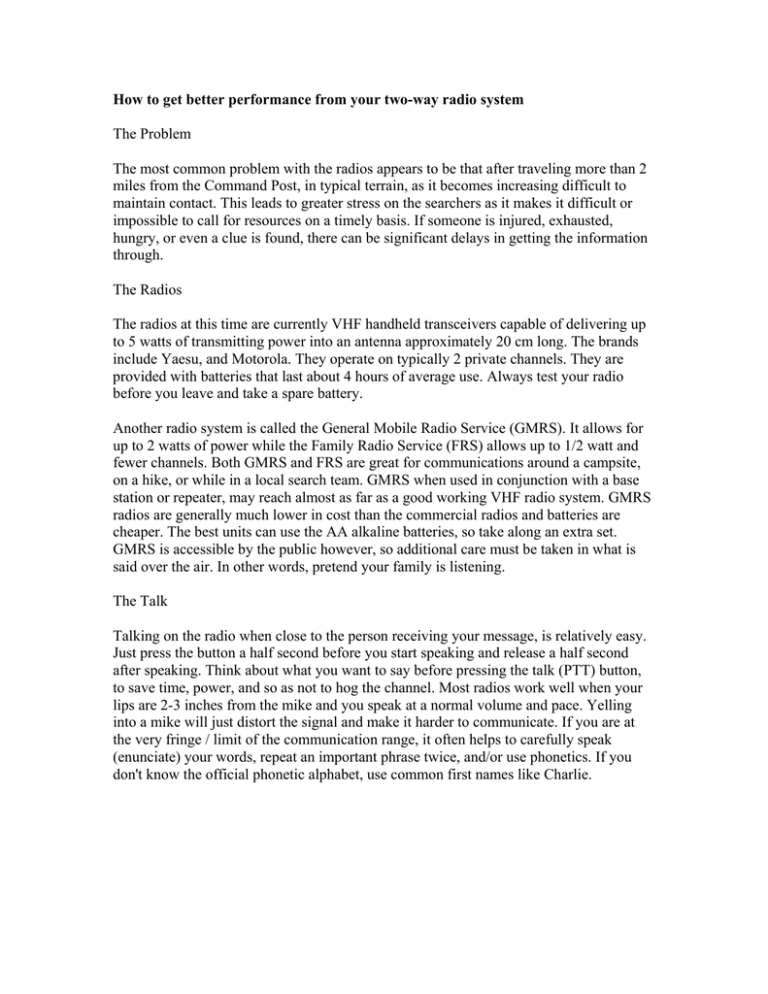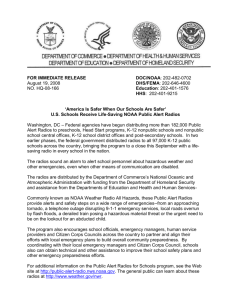How to Get More Performance From Your Hand Held Radio
advertisement

How to get better performance from your two-way radio system The Problem The most common problem with the radios appears to be that after traveling more than 2 miles from the Command Post, in typical terrain, as it becomes increasing difficult to maintain contact. This leads to greater stress on the searchers as it makes it difficult or impossible to call for resources on a timely basis. If someone is injured, exhausted, hungry, or even a clue is found, there can be significant delays in getting the information through. The Radios The radios at this time are currently VHF handheld transceivers capable of delivering up to 5 watts of transmitting power into an antenna approximately 20 cm long. The brands include Yaesu, and Motorola. They operate on typically 2 private channels. They are provided with batteries that last about 4 hours of average use. Always test your radio before you leave and take a spare battery. Another radio system is called the General Mobile Radio Service (GMRS). It allows for up to 2 watts of power while the Family Radio Service (FRS) allows up to 1/2 watt and fewer channels. Both GMRS and FRS are great for communications around a campsite, on a hike, or while in a local search team. GMRS when used in conjunction with a base station or repeater, may reach almost as far as a good working VHF radio system. GMRS radios are generally much lower in cost than the commercial radios and batteries are cheaper. The best units can use the AA alkaline batteries, so take along an extra set. GMRS is accessible by the public however, so additional care must be taken in what is said over the air. In other words, pretend your family is listening. The Talk Talking on the radio when close to the person receiving your message, is relatively easy. Just press the button a half second before you start speaking and release a half second after speaking. Think about what you want to say before pressing the talk (PTT) button, to save time, power, and so as not to hog the channel. Most radios work well when your lips are 2-3 inches from the mike and you speak at a normal volume and pace. Yelling into a mike will just distort the signal and make it harder to communicate. If you are at the very fringe / limit of the communication range, it often helps to carefully speak (enunciate) your words, repeat an important phrase twice, and/or use phonetics. If you don't know the official phonetic alphabet, use common first names like Charlie. The Batteries Batteries come in many types and capacities and here are the most common. Rechargeable are the older Nickel Cadmium (NiCad), the modern Nickel Metal Hydride (NiMH) and Lithium Ion. Single use batteries include the older (cheap/short life) Carbon Zinc, the popular Alkaline (i.e. copper top), and a few other types. The Squelch For radios with a squelch knob, be sure to set it not more than 1/8 of a turn from the point where it just quiets the static noise. The Antenna When more than a mile from the Command Post, try to keep the antenna vertical to obtain the best reception. Also turning so your body does not come between the antenna and the Command Post (or other point communicating to) should help. Raising the radio above your head while using the external (cabled) microphone is also helpful. A longer or special portable antenna (or reflector) could be made available in special circumstances, that could be used while stopped at a distance location. Keep the antenna clear of as much metal as possible as it could absorb some of the radio waves. The Location Where possible, try to stand clear of large trees in the direction of communication. Get out of the ravine, gully or dip in land if possible. Standing on any hill (even if just 5 feet tall) or in a clearing will help. With VHF or UHF land based communications, higher is always better. Getting above the treetops is much better that doubling your transmit power. The Channels We will normally use the River Valley (173) frequency for YSSR communication from the field to the Command Post. In searches where Tri-County (Moncton) is involved, there (162) frequency might be used. Certain other frequencies may be used at the Command Post to link to various provincial government services through the PMCC system. Where GMRS radios are used, channels (i.e. 7 or 6) may be selected for use within a team or between teams working a particular area. Channel 20 can be used for high priority traffic of interest to the Command Post. Note channels 1-14 are for FRS (1/2watt short distance use) Channels 15- and above are for GMRS units to transmit in high power (2 watt mode). The Repeaters A repeater may be used in a search to assist in distant communication. A simplex repeater records an incoming transmission (up to 30 seconds) and then rebroadcasts it. It will sound like an echo to the person sending it and will appear to have a delay to a person you may be talking to in the distance. The delay is a bit like what you may have noticed on CNN as they talk to a reporter on the other side of the world. Please think before you speak to avoid delays and make efficient use of the channel. Wait for the beep before you take your turn speaking. A cross-band repeater may be used at some point to assist in distant communication. This will be a special radio system (battery powered) placed at a high location (hill or tall tree) in the search area. The equipment will likely link the VHF radios through a UHF radio system, to the Command Post. This can more than double the range of radios in the field. The users of the VHF radios just need to know the channel and follow good radio etiquette - no special radio knowledge is required by the search crew. In the CP, the radio operator will use a designated UHF frequency (i.e. 440-450 MHz on Low power). A separate channel will be set aside for the repeater such as Channel 21 GMRS or the alternate (secondary) channel on VHF. The Command Post Additional issues need to be addressed at the CP, such as antennas, cables, poles/towers, preprogrammed radios and multi-purpose radios like the Kenwood TM-D700A. Radios must be connected to the proper antennae to insure a proper electrical match and efficient signal propagation. More on this later for those that want to learn. A new discone antenna is now available for use on the CP. It is somewhat fragile and takes perhaps 15 minutes to assemble. It consists of 8 rods 32 inches long that angle downward and 8 rods 11 inches long that form a disc at the top. This antenna can be used to transmit and receive on all band from 118 MHz to 1.3 GHz. This includes aircraft, marine, fire, police, commercial, and some cellular.



